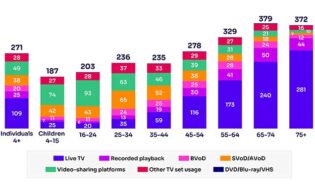According to Ofcom’s latest annual report, the proportion of viewers who tune in to traditional broadcast TV each week has seen the steepest-ever annual fall, from 83 percent in 2021 to 79 percent in 2022.
The report finds that BBC One remains the only channel to reach more than half of the viewing population every week.
A similar decline is shown in the average time viewers spend watching broadcast TV daily, down from 2 hours 59 minutes in 2021 to 2 hours 38 minutes in 2022—a drop of 12 percent. For the first time, there is evidence of a significant decline in average daily broadcast TV viewing among “core” older audiences (aged 65 plus), dropping 8 percent year on year and 6 percent on pre-pandemic levels.
The report also reveals a steep decline in programs attracting “mass audiences.” The number of programs with more than 4 million TV viewers has halved over the past eight years, from 2,490 in 2014 to 1,184 in 2022. These declines reflect fewer people watching the main early and late evening TV news bulletins and a steady decline in viewing figures for the three most popular soaps: Coronation Street, EastEnders and Emmerdale. Only 48 programs averaged over 4 million TV viewers on streaming platforms in 2022, with Netflix accounting for the vast majority.
Despite the continuing decline of traditional broadcast TV viewing, BBC One (20 percent) and ITV1 (13 percent) are still the top two first destinations for viewers when they turn on their TV, with Netflix coming in third (6 percent). In addition, watching broadcasters’ content—either live, on recorded playback or streamed on-demand—still accounts for the greatest proportion of all time spent each day watching TV and video (60 percent; 2 hours 41 minutes per person, per day).
The use of broadcasters’ video-on-demand services, such as BBC iPlayer and ITVX, continues to grow. ITVX accounted for 10 percent of ITV’s total viewing in the first half of 2023, up from 7 percent across 2022. BBC iPlayer rose from 14 percent of the BBC’s total viewing to 18 percent during the same period.
Public perception of the public-service broadcast channels remains positive, with seven in ten viewers (69 percent) saying they were satisfied with them overall. In the list of most-watched programs in 2022, PSB events performed strong, with England’s quarter-final in the FIFA World Cup (16.1 million viewers), HM Queen Elizabeth II’s state funeral (13.2 million viewers) and the Platinum Jubilee (13.2 million viewers) holding the top spots.
In 2022, the PSBs were able to return to full production schedules. As a result, PSB spend on first-run original programs totaled £2.9 billion, up 10.3 percent year on year and 14.2 percent greater than in 2019, while hours broadcast climbed to their highest point since 2016: 32,712.
Yih-Choung Teh, group director of strategy and research at Ofcom, said: “Today’s viewers and listeners have an ‘all-you-can-eat’ buffet of broadcasting and online content to choose from, and there’s more competition for our attention than ever.
“Our traditional broadcasters are seeing steep declines in viewing to their scheduled, live programs, including among typically loyal older audiences, and soaps and news programs don’t have the mass-audience pulling power they once had.
“But despite this, public-service broadcasters are still unrivaled in bringing the nation together at important cultural and sporting moments, while their on-demand players are seeing positive growth as they digitalize their services to meet audience needs.”


